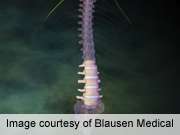(HealthDay)—Nonadherent magnetic resonance imaging (MRI) utilization is tied to a cascade of higher medical costs and potentially unnecessary and unhelpful medical services following the MRI, according to research published in the Aug. 1 issue of Spine.
Barbara S. Webster, from the Liberty Mutual Research Institute for
Safety in Hopkinton, Mass., and colleagues used data from a longitudinal workers' compensation administrative data source to identify low back claims filed in 2006. Health care utilization was evaluated by classification of MRI timing (early, timely, or no MRI) and by severity (more or less severe) at three, six, nine, and 12 months post-MRI.
The researchers found that adjusted relative risks for receipt of electromyography, nerve conduction testing, advanced imaging, injections, and surgery within six months post-MRI ranged from 6.5- to 54.9-times the rate for the reference group (no MRI, less severe). The adjusted relative risks to receive most services were similar for the timely and early MRI less severe subgroups. The adjusted relative risks were higher for the early MRI more severe subgroup than timely MRI more severe subgroup cases. Both early MRI subgroups had the highest medical costs, and these costs increased the most over time.
"Study results provide evidence to promote provider and patient conversations to help patients choose care that is based on evidence, free from harm, less costly, and truly necessary," the authors write.
Several authors disclosed financial ties to insurance companies, including Liberty Mutual, which sponsored the study.
More information:
Abstract
Full Text (subscription or payment may be required)
Journal information: Spine
Copyright © 2014 HealthDay. All rights reserved.






















